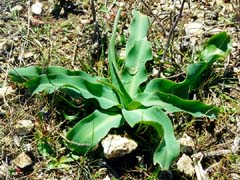Liliaceae (Lily
Family)
Liliaceae is a large family, with hundreds of exotic species in cultivation. They include hyacinths, tulips, onions, as well as the true lilies. This family is well represented in the Bay Area natives, many of which have become native garden favorites.
All species are prerennial, but most are herbaceous (not having a woody stem) and die back, after flowering or fruiting, to underground bulbs, corms, or rhizomes. New plants form from bulb division or sprout from seeds, but usually do not begin flowering until about the fourth year, after the bulb has developed sufficiently.
The flowers have 3 petals and 3 sepals, often very similar (in which they are referred to as perianth segments: you needed to know that, I'm sure.) There are typically 6 stamens. The fruit is either dry and cracking at maturity or fleshy in certain species - it is divided into 3 segments. There are few exceptions to the above general description.
